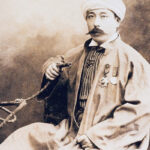

徳川家光 Tokugawa Iemitsu
1604 – 1651
childhood name : Takechiyo → Iemitsu
3rd Shogun of Edo
One of the Greatest Innovator of Japan
Overview of The Tokugawa Period
The Tokugawa period, also known as the Edo period, was the last of the traditional Japanese periods of domestic peace, political stability, and economic development under the shogunate (military dictatorship) established by Ieyasu Tokugawa. The Tokugawa family had a remarkable impact on Japanese history. In this article, we will discuss the life and legacy of Tokugawa Iemitsu, grandson of one of the most famous shoguns, Tokugawa Ieyasu, and how he remade Japan.
Japan has a very unique historical pattern which is that warlords rule the world by utilizing emperors like string puppets. You may wonder-since when has this pattern started? It started during the lifetime of Tokugawa Iemitsu (1604-1651), a shogun and a warlord. As the third leader of the Tokugawa shogunate (a dynasty of shoguns composed of this family), he implemented many of the policies that would come to define Japan for centuries to come.
Overview of Tokugawa Iemitsu’s Reign
Tokugawa Iemitsu was the grandson of one of the most famous shoguns, Tokugawa Ieyasu, and the son of Tokugawa Hidetada. Although Tokugawa Iemitsu was favored by his grandfather, Tokugawa Ieyasu, his parents favored his younger brother Tadanaga. His parents kept recommending Tadanaga to become the next head of the Shogunate as Hidetada’s successor, but Ieyasu demanded Iemitsu to be put in that position instead. Ieyasu cherished Iemitsu so much that even his childhood name Takechiyo, was the same as Ieyasu’s.
In 1617, Iemitsu celebrated his coming of age, changed his name from Takechiyo to Iemitsu, and officially announced that he would be the next shogun. Iemitsu’s reign as a shogun began in 1623, and he ruled Japan for nearly 30 years, instituting a wide range of political, economic, and cultural reforms.
Iemitsu and the Shogunate
Tokugawa Iemitsu implemented reforms that characterized Japan for centuries.
First, he strengthened the power of the shogun to protect the shogunate from other warlords. During Hidetada’s (Iemitsu’s father) reign, feudal warlords (daimyo) were powerful, wealthy, and a real threat. The Tokugawa succeeded in quelling most of the fighting, and by the time Iemitsu came to power, the feudal lords were bankrupt, battle-weary, and disorganized. Iemitsu sought to keep them that way. Iemitsu enacted a series of laws to make it difficult for the daimyo to regain power, such as requiring them to establish emergency residences in Edo. As a result, the feudal lords could not become wealthy again. The system of “sankinsho,” or “visiting feudal lords,” was formalized by Iemitsu, under which the daimyo would travel back and forth between the provinces and Edo to serve the court in Edo for a certain period of time, and then establish a separate residence in Edo and hold their families hostage. This system was one way to control the feudal lords and was also intended to prevent them from spending money on the purchase of weapons and armor and the maintenance of armies, as they were financially impoverished.
Iemitsu also further restricted the power of the emperor. While the emperor was the leader of the country, Iemitsu further curtailed the emperor’s real power, making him a mere figurehead for Tokugawa privileges.
To create a stronger state and shogunate, Tokugawa Iemitsu instituted a series of social reforms aimed at education and codes of conduct, reforming the administration and severely restricting the lords’ codes of conduct.
Iemitsu and Foreign Policy
The greatest legacy of Tokugawa Iemitsu’s reign is his foreign policy. The Tokugawa Shogunate implemented a policy of “seclusion,” which prohibited foreigners from entering the country and Japanese people from leaving. In the 1630s, Iemitsu also banned Christianity by expelling missionaries from the country. Furthermore, the Tokugawa shogunate officially adopted a policy of seclusion in 1633, where Japanese people were forbidden to travel abroad or return from abroad, and foreign contacts were limited to a few Chinese and Dutch merchants who were allowed to trade in the southern part of Japan.
Iemitsu and Political Stability
To gain political stability, Iemitsu feared the foreign ideological and military intervention. Iemitsu especially saw Roman Catholic missionaries as a threat after learning that the colonial expansion of Spain and Portugal into Asia had been made possible by their work of them. Iemitsu took over what his father Hidetada did, which was horrible persecutions of the Christians. Iemitsu expelled and executed the remaining missionaries in Japan and forced Japanese citizens to register with Buddhist parishes.
In 1637, due to excessive taxation, farmers brought about a strike. When Iemitsu learned that a large number of Christians were among them, he retaliated with troops and fought against the rebellion. After the Shimabara Rebellion, which lasted several months, the peasants surrendered, resulting in their massacre by the Shogun’s troops.
On June 8, 1651, Shogun Iemitsu died at the age of 47. He was succeeded by his son, Tokugawa Ietsuna.
.
.
.
.
.




